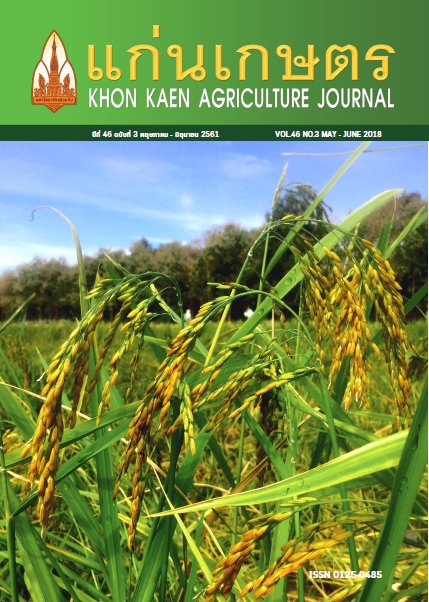การเปรียบเทียบอัตราการเจริญเติบโต และสัณฐานวิทยาของครามฝักตรง (Indigofera tinctoria L.), ระหว่างต้นดิพพลอยด์ และเตตราพลอยด์
Main Article Content
บทคัดย่อ
การศึกษานี้เป็นการศึกษาเปรียบเทียบลักษณะต้นครามฝักตรงดิพพลอยด์ และเตตราพลอยด์ ที่เกิดจากการชักนำด้วยโคลชิซิน เพื่อเปรียบเทียบอัตราการเจริญเติบโต และลักษณะทางสัณฐานวิทยา เพื่อพิจารณาลักษณะเบื้องต้นของครามฝักตรง ก่อนที่จะทำการศึกษา และประเมินผลผลิตในสภาพแปลงต่อไปในอนาคต จากการศึกษาอัตราการเจริญเติบโตของต้นเตตราพลอยด์ และต้นดิพพลอยด์ จากลักษณะต่าง ๆ พบว่า อัตราการเจริญเติบโตจากลักษณะจำนวนใบประกอบ และจำนวนกิ่ง ของต้นเตตราพลอยด์มีค่ามากว่าต้นดิพพลอยด์อย่างมีนัยสำคัญยิ่งทางสถิติ แต่พบว่า อัตราการเจริญเติบโตจากความสูง เส้นรอบวง จำนวนข้อของต้นเตตราพลอยด์ และต้นดิพพลอยด์มีค่าไม่แตกต่างกันทางสถิติ อย่างไรก็ตาม มีแนวโน้มว่า อัตราการเจริญเติบโตของต้นเตตราพลอยด์จะมีค่ามากกว่าดิพพลอยด์ในทุกลักษณะ เมื่อศึกษาลักษณะของต้นครามฝักตรงที่เป็นต้นดิพพลอยด์ กับต้นเตตราพลอยด์เปรียบเทียบกันในสัปดาห์ที่ 17 พบว่า ต้นครามฝักตรง ที่เป็นต้นดิพพลอยด์ กับต้นเตตราพลอยด์มีความสูง เส้นรอบวงต้น จำนวนข้อ จำนวนกิ่ง จำนวนใบย่อยต่อ 1 ใบประกอบ มีลักษณะไม่แตกต่างกันทางสถิติ แต่พบว่า มีจำนวนใบประกอบแตกต่างกันอย่างมีนัยสำคัญยิ่งทางสถิติ โดยใบของต้นดิพพลอยด์ มีจำนวนใบมากกว่าใบของต้นเตตราพลอยด์ ต้นเตตราพลอยด์มีความกว้าง ใบย่อย และดัชนีใบมากกว่าต้นดิพพลอยด์อย่างมีนัยสำคัญยิ่งทางสถิติ ส่วนความยาวใบไม่แตกต่างกัน นอกจากนี ้ยังพบว่า น้ำหนักใบประกอบ น้ำหนักใบย่อย พื ้นที่ใบย่อย น้ำหนักใบย่อย/พื ้นที่ใบย่อย ของต้นเตตราพลอยด์มีแนวโน้มมากกว่าต้นดิพพลอยด์
Article Details
เอกสารอ้างอิง
สุนทรีย์ สุรศร. 2560ก. การตรวจสอบลักษณะทางสัณฐานของส้มเขียวหวาน (Citrus reticulata Blanco) ดิพพลอยด์ และเตตราพลอยด์. ว. วิทย. กษ. 48: 100–107.
สุนทรีย์ สุรศร. 2560ข. รายงานการวิจัยการสร้างครามโพลีพลอยด์พันธุ์ฝักตรง (Indigofera tinctoriaL.) : คณะเทคโนโลยีการเกษตร มหาวิทยาลัยราชภัฎสกลนคร.
Blakeslee A. F., and A. G. Avery. 1937. Method of inducing doubling of chromosome in plants by treatment with colchicine. J. Herd. 28:393-411.
Bouvier, L., F.R. Fillon, and Y. Lespinasse. 1994. Oryzalin as efficient and cytological characters of triploid pineapples. Cytologia. 4:248-256.
Chen, R., W. Jiang, Q. Li, X. Li, X. Chen, Y. Yang, and H. Wu, 2016. Comparison of seven colchicine-induced tetraploid clones with their original diploid clones in purple coneflower (Echinacea purpurea L.). Euphytica. 207: 387-399.
Daughtry, C.S.T. 1990. Direct measurements of canopy structure. Remote Sens. Rev. 5: 45–60.
De Jesus-Gonzalez L., and P.J. Weathers. 2003. Tetraploid Artemisia annua hairy roots produce more artemisinin than diploids. PlantCellRep. 21: 809-813.
Dehghan, E., S. T. Hakkinen, K. Oksman-Caldentey, and F. S. Ahmadi. 2012. Production of tropane alkaloids in diploid and tetraploid plants and in vitro hairy root cultures of Egyptian henbane (Hyoscyamus muticusL.). Plant Cell Tiss Organ Cult. 110: 35–44.
He, L.Y., Z. Ding, F. Jiang, B. Jin, W. Li, X. Ding, J. Sun, and G. Li. 2012. Induction and identification of hexadecaploid of Pinellia ternate. Euphytica. 186: 479–488.
Ling, J.T,. and M. Iwamasa. 1994. Somatic Hybridization between Citrus reticurataand Citropsis gabunnensis through Electrofusion. Plant Cell Rep. 13: 493–497.
Kaensaksiri, T., P. Soontornchainaksaeng, N. Soonthornchareonnon, and S. Prathanturarug. 2011. In vitro induction of polyploidy in Centella asiatica (L.) Urban. Plant Cell Tiss. Org. Cult. 107: 187–194.
Kim, Y., E. Hahn, H.N. Murthy, and K. Paek. 2004. Effect of polyploidy induction on biomass and ginsenoside accumulations in adventitious roots of ginseng. JournalofPlantBiology. 47: 356-360.
Laere, K.V., S.C. Franca, H. Vansteenkiste, J.V. Huylenbroeck, K. Steppe, andM.V. Labeke. 2011. Influenceofploidylevelonmorphology, growthanddroughtsusceptibilityinSpathiphyllumwallisii. ActaPhysiolPlant. 33: 1149–1156.
Liu, G., Z. Li, andM. Bao. 2007. ColchicineinducedchromosomedoublinginPlatanusacerifoliaanditseffectonplantmorphology. Euphytica. 157: 145–154.
NtuliN.R., andA.M. Zobolo. 2008. EffectofwaterstressongrowthofcolchicineinducedpolyploidCocciniapalmataandLagenariasphaericaplants. Afr. J. Biotechnol. 7: 3648-3652.
Otto, S. P., andJ. Whitton. 2000. Polyploidinduceandevolution. Annu. Rev. Genet. 2000. 34: 401–37
PlanchiaisS. N. Glab, D. Inze, andC. Bergonioux. 2000. Chemicalinhibitors : atoolforplantcellcyclestudies. FEBSLell. 476: 78-83.
Rego, M.M., E.R. Rego, C.H. Bruckner, F.L. Finger, andW.C. Otoni. 2011. Invitroinductionofautotetraploidsfromdiploidyellowpassionfruitmediatedbycolchicineandoryzalin. PlantCellTiss. OrganCutt. 107: 451-471.
SAS., 1998. SAS/STATUser’sGuide. Version6, SASInstituteInc., Cary, NorthCarolina, USA.Serapiglia, M. J., F. E. Gouker, and L. B. Smart. 2014. Early selection of novel triploid hybrids of shrub willow with improved biomass yield relative to diploids. BMC Plant Biology. 14: 1-12.
Taylor, N. L., K.H. Anderson, K.H. Wuesenberry, and C. Watson. 1976. Doubling the chromosome number of trifolium species using nitrus oxide. Crop Sci. 16: 516-518.
Thong-on, W., P. Arimatsu, S. Pitiporn, N. Soonthronchareonnon, and S. Prathanturarug. 2014. Field evaluation of in vitro-induced tetraploid and diploid Centella asiatica (L.) Urban. J. Nat Med. 68: 267-273.
Tuyl, J.M.V., B. Meijer, and M.P. Van Dien. 1992. The use of oryzalin as alternative for colchicine in in vitro chromosome doubling of Liium and Nerine. Acta Hort. 325: 625-629.
Wang, Z., M.Wang, L.Liu, and F. Meng. 2013. Physiological and Proteomic Responses of Diploid and Tetraploid Black Locust (Robinia pseudoacacia L.) Subjected to Salt Stress. Int. J. Mol. Sci. 14: 20299-20325.
Zhang, F., H. Xue, X. Lu, B. Zhang, F. Wang, Y. Ma, and Z. Zhang. 2015 Autotetraploidization enhances drought stress tolerance in two apple cultivars. Trees. 29: 1773–1780.


